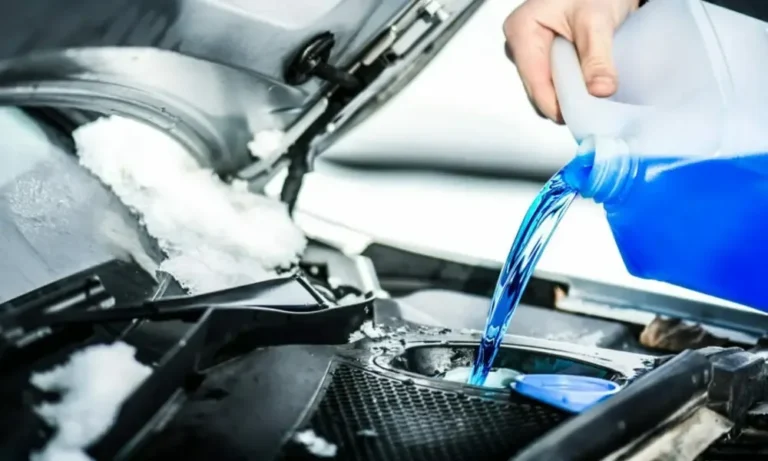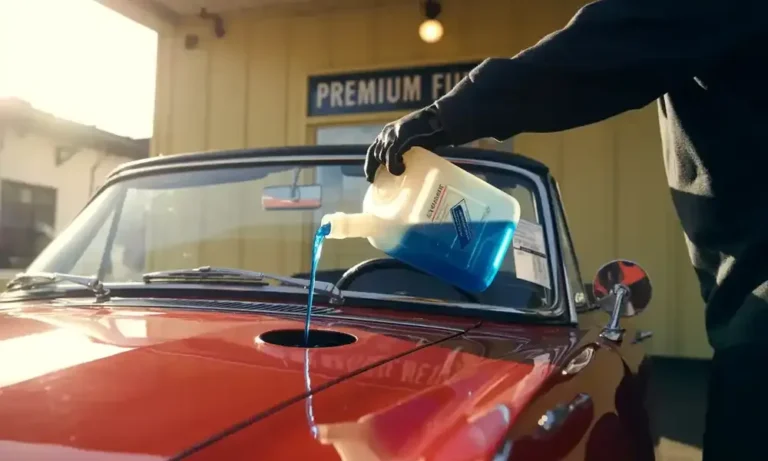Will Windshield Wiper Fluid Hurt A Radiator
Will windshield wiper fluid hurt a radiator? Yes, it absolutely can. While it may seem like all car fluids are interchangeable, putting windshield wiper fluid in a radiator is a serious mistake that can lead to engine problems and expensive repairs. Since both are liquids kept beneath the hood, people frequently mistake washer fluid for coolant. But they serve completely different purposes. Washer fluid is meant to clean your windshield, not cool your engine. If you accidentally pour windshield wiper fluid in the radiator, it can corrode internal components, reduce cooling efficiency, and even cause the engine to overheat. Misusing fluids in your vehicle’s systems may seem minor, but it can create major mechanical risks. Always double-check before topping off any reservoirs under the hood.
Will Windshield Wiper Fluid Hurt a Radiator?

Yes, windshield wiper fluid can damage your radiator and engine if poured into the coolant reservoir. It is not intended for engine cooling or high temperatures. If you’ve accidentally put windshield fluid in coolant, it’s important to address it quickly to avoid costly repairs.
Washer Fluid vs. Coolant: Key Differences
Windshield washer fluid (sometimes labeled antifreeze windshield washer fluid for winter use) is made to clean your windshield. It may contain alcohols, detergents, and dyes. It does not have the properties needed to regulate engine temperature.
Coolant, also called antifreeze, is a specially formulated fluid that flows through your engine and radiator to manage heat and prevent freezing. It usually contains ethylene glycol or propylene glycol, plus additives to prevent corrosion.
Feature | Windshield Washer Fluid | Coolant / Antifreeze |
Main Use | Cleaning windshield | Regulating engine temperature |
Composition | Water, alcohol, detergents | Ethylene/propylene glycol, rust inhibitors |
Heat Resistance | Low | High |
Corrosion Protection | No | Yes |
Safe for Engine System? | No | Yes |
What Happens If You Accidentally Put Windshield Fluid in Coolant?
The consequences of inadvertently spilling windscreen washer fluid into your radiator or coolant reservoir might be severe:
- Overheating: The engine may overheat as a result of washer fluid decreasing the effectiveness of your cooling system.
- Corrosion: Because it doesn’t contain anti-corrosion compounds, it could harm metal parts like the water pump and radiator.
- Engine Damage: Continuous use can lead to permanent engine damage if not flushed out in time.
Even antifreeze windshield washer fluid is not a substitute for real engine coolant. It only prevents the washer system from freezing, not your engine.
What to Do Immediately After the Mistake
- Do Not Start the Engine.
- Drain the Cooling System Completely.
- Use water or the appropriate coolant flush to clean the system.
- Refill With Manufacturer-Recommended Coolant.
- Check for Damage or Consult a Mechanic.
Repair Costs If Washer Fluid Enters Radiator
Costs may vary if you drive with windscreen fluid in the coolant by mistake:
Repair Type | Estimated Cost (USD) |
System Flush Only | $100 – $250 |
Radiator Replacement | $300 – $900 |
Water Pump Replacement | $400 – $700 |
Engine Overhaul (Severe) | $1,500 – $4,000+ |
Prompt action can save you hundreds, even thousands. Delaying repair increases the chance of system corrosion and overheating.
You should also read about Can You Put Water In Windshield Wiper Fluid?
How Does Windshield Washer Fluid Work?
Windshield washer fluid is designed specifically to clean your windshield, not to cool your engine. If you’ve ever wondered how it works, or why putting washer fluid in radiator systems is dangerous, this guide breaks it down.
What’s the Purpose of Windshield Washer Fluid?
The main job of windshield washer fluid is simple:
To clean your windshield and improve driving visibility.
It helps remove dirt, bugs, road salt, bird droppings, and other debris with a quick spray and wipe from your windshield wipers.
What Is Windshield Washer Fluid Made Of?
Washer fluid is formulated for cleaning—not engine performance. Common components include:
- Water – Acts as a base for the solution
- Methanol or Ethanol – Prevents freezing in cold weather
- Detergents – Helps loosen grime and dirt
- Dyes or Fragrances – For visibility and scent (optional)
Some types may be labeled as antifreeze windshield washer fluid, but this only applies to freezing temps in the washer system—not your engine’s cooling system.
How Does the Windshield Washer System Work?
Here’s a quick breakdown of the system:
- Washer Fluid Reservoir: Stores the fluid.
- Washer Pump: Sends fluid through the system when activated.
- Hoses and Tubing: Channels the fluid to the windshield.
- Spray Nozzles: Evenly spray fluid across the glass.
- Wiper Blades: Wipe away debris and moisture.
When you pull the washer stalk or press a button, the pump activates and sprays fluid through the nozzles. It’s a basic but essential safety feature.
Why Washer Fluid Does NOT Belong in the Radiator
If you’ve mistakenly poured windshield wiper fluid in radiator systems, it’s important to understand why this is a serious issue.
Washer fluid is not made for high-heat environments. It lacks the key ingredients needed to regulate engine temperature or prevent rust. Here’s why it’s harmful:
- No Heat Management: Washer fluid can’t absorb or disperse heat like coolant can.
- No Corrosion Protection: Unlike coolant, it doesn’t contain anti-corrosion additives.
- Chemical Breakdown: High engine temps can break down washer fluid components, possibly leading to gunk buildup.
- Risk of Engine Overheating and Damage
Washer Fluid in Radiator – What to Do If It Happens
If you’ve put washer fluid in the radiator, do not drive the vehicle. Flush the system immediately or take it to a mechanic for a professional coolant flush. Waiting can result in:
- Engine overheating
- Radiator corrosion
- Water pump damage
- Expensive repairs
You can also read about Windshield Wiper Fluid.
Where to Put Windshield Wiper Fluid?

You should always pour windshield wiper fluid into the windshield washer fluid reservoir—not the radiator or coolant tank.
How to Identify the Washer Fluid Reservoir
- Location: Usually near the front of the engine bay
- Cap Color: Typically blue, white, or black
- Label: Often shows a windshield icon with water spray
Don’t confuse it with the coolant cap or radiator cap, which are usually pressurized and may be marked with warnings or temperature symbols.
Step-by-Step: How to Refill Washer Fluid
- Turn off the engine and open the hood.
- Locate the washer fluid reservoir—look for the cap with a windshield spray symbol.
- Open the cap and place a funnel inside.
- Pour in windshield washer fluid slowly until it reaches near the top.
- Close the cap tightly and lower the hood.
Quick Tip
If you accidentally poured washer fluid in radiator, stop driving and have the system flushed immediately to prevent overheating or engine damage.
Knowing where and how to fill the correct reservoir helps avoid costly mistakes and keeps your windshield clear and safe.
What Happens If You Accidentally Put Windshield Washer Fluid in Radiator?
If you’ve accidentally put windshield fluid in coolant, it can cause serious engine issues—especially if not fixed quickly.
Short-Term vs. Long-Term Effects
- Short-Term:
You might not notice immediate problems. However, windshield washer fluid isn’t made to handle engine heat, so it weakens your cooling system’s performance. - Long-Term:
If left inside, antifreeze windshield washer fluid can break down and:- Cause engine overheating
- Lead to corrosion in the radiator and water pump
- Create sludge buildup, blocking coolant flow
- Eventually damage your engine
Signs You May Have Contaminated Coolant
- A sweet or unusual smell from the engine
- Overheating or rising temperature gauge
- Colored liquid (blue or green) in the coolant reservoir
- Poor heater performance in colder months
These are signs that windshield washer fluid has mixed with your coolant system.
What to Do Immediately
- Don’t drive the vehicle—this can worsen engine damage.
- Check the coolant reservoir for signs of contamination.
- Drain and flush the cooling system ASAP.
- Refill with proper engine coolant, as recommended by your vehicle’s manual.
- If unsure, visit a mechanic for a professional flush and inspection.
Can You Put Windshield Washer Fluid in While the Car Is Running?
No, it’s not recommended to add windshield washer fluid while the car is running. For safety and accuracy, the car should be turned off and cooled down before you refill.
Why the Car Should Be Off and Cool
- Avoid Burns: Even though the washer fluid system isn’t pressurized, other parts under the hood—like the radiator—can be extremely hot after driving.
- Prevent Mistakes: A running engine can make it easier to accidentally confuse the washer fluid reservoir with the radiator cap, which is dangerous to open when hot.
- Reduce Risk of Pressure Accidents: While not common in washer systems, opening the wrong cap—like the coolant reservoir or radiator—can cause fluid to spray due to pressure.
Best Time to Refill Washer Fluid
- When the engine is off and cool (ideally before starting your day or after a drive with time to cool)
- During routine maintenance checks or before long trips
- Anytime you notice the spray is weak or empty
Important Reminder
If you’ve put washer fluid in radiator or added windshield wiper fluid in radiator by mistake, don’t start the car. Flush the system immediately or contact a mechanic to prevent engine damage.
Refilling washer fluid is easy—but always do it safely and use the correct reservoir to avoid costly problems.
Final Thoughts
If you’ve made the mistake of putting windshield wiper fluid in radiator or need help with any auto glass or cooling system service, Texas Reliable Auto Glass is here for you. Our experts can help flush your system and ensure your vehicle is running smoothly. Contact us today for professional assistance and peace of mind!
FAQs
What Should I Do If I Put Windshield Wiper Fluid In The Radiator?
If you’ve accidentally put windshield wiper fluid in radiator, do not drive your car. The system should be flushed immediately to prevent overheating and potential engine damage. It’s best to contact a mechanic for assistance.
What Are The Risks Of Using Windshield Washer Fluid In The Engine Cooling System?
Using windshield washer fluid in the radiator can lead to overheating, corrosion, and eventual engine damage. Since washer fluid lacks the necessary properties to manage high engine temperatures, it compromises your vehicle’s cooling system.
Can Windshield Wiper Fluid Cause Overheating?
Yes, if windshield wiper fluid is in the cooling system, it can prevent proper heat dissipation, which can lead to engine overheating. This can cause lasting damage if not addressed quickly.
How Can I Tell If My Coolant Is Contaminated With Washer Fluid?
Signs of contamination include a sweet or chemical smell, overheating, and discolored coolant (usually blue or green, depending on the washer fluid). If you notice any of these, have your system flushed immediately.

